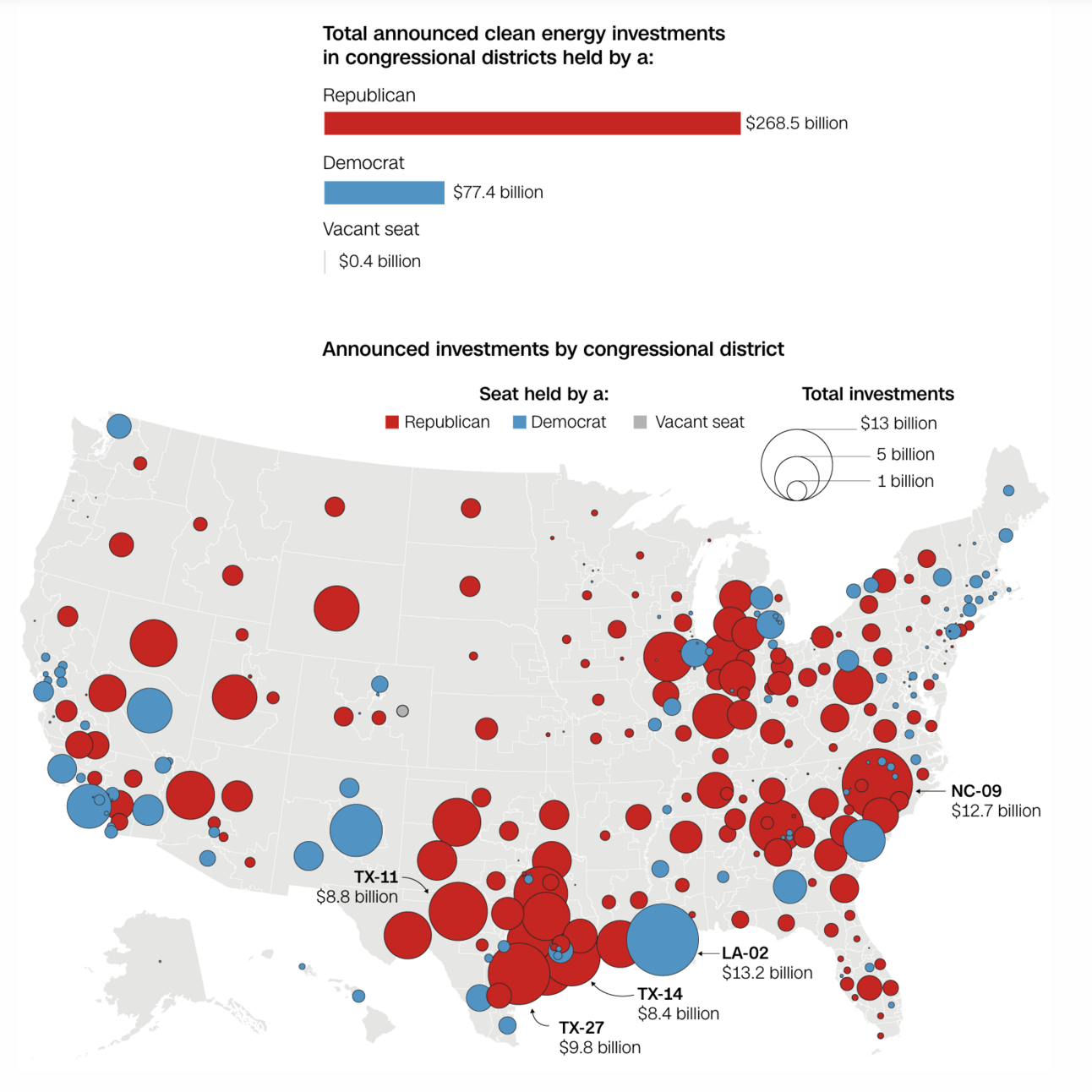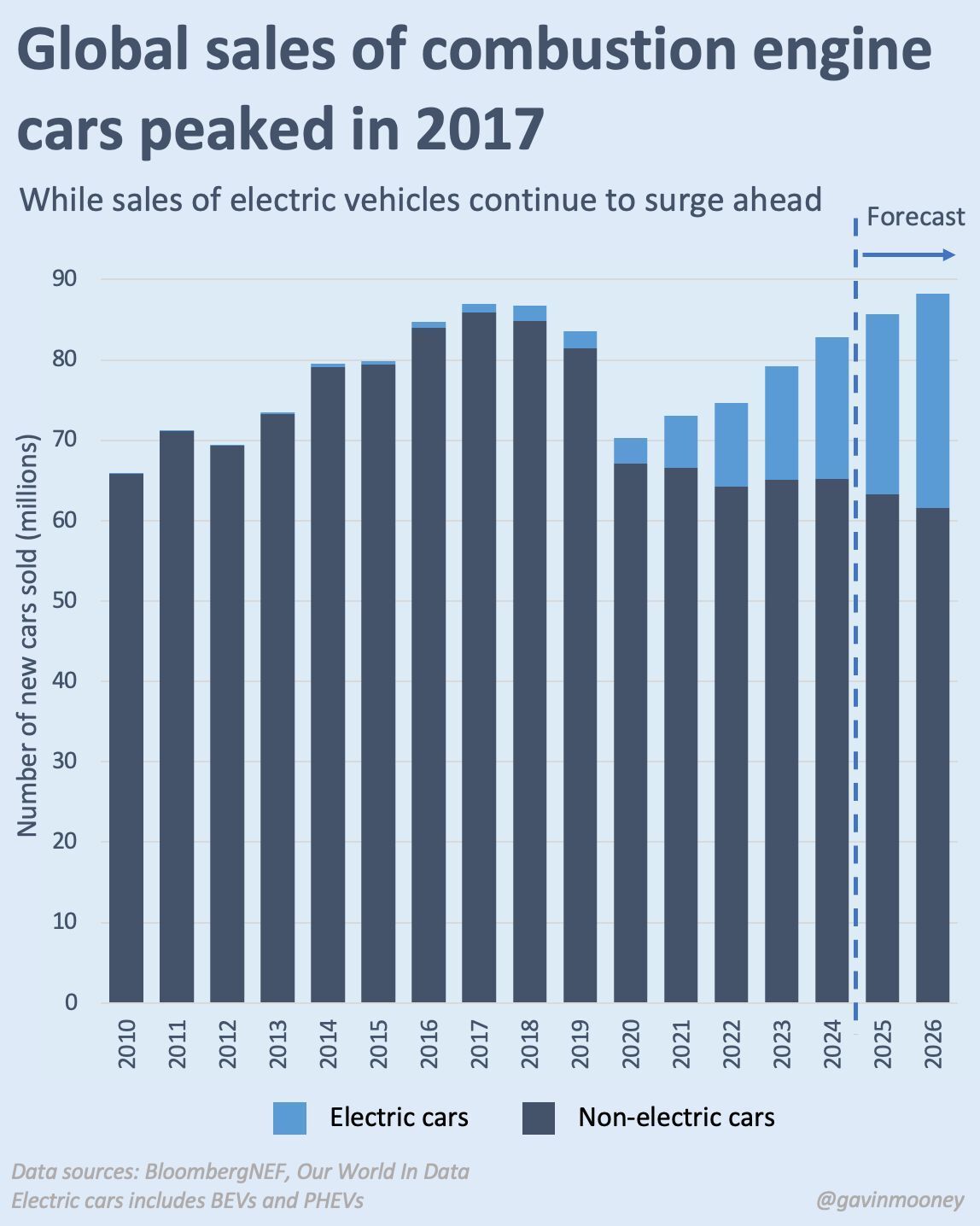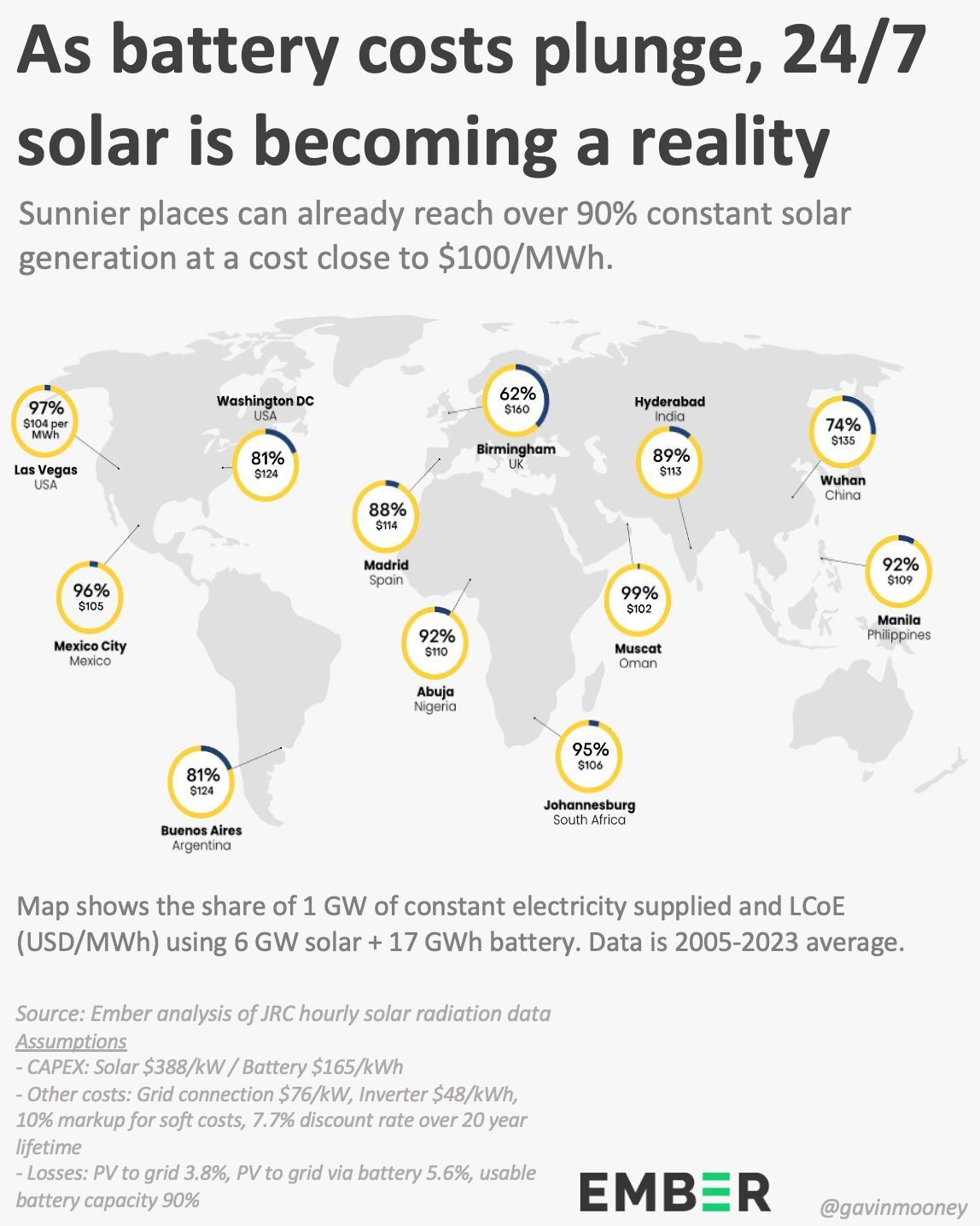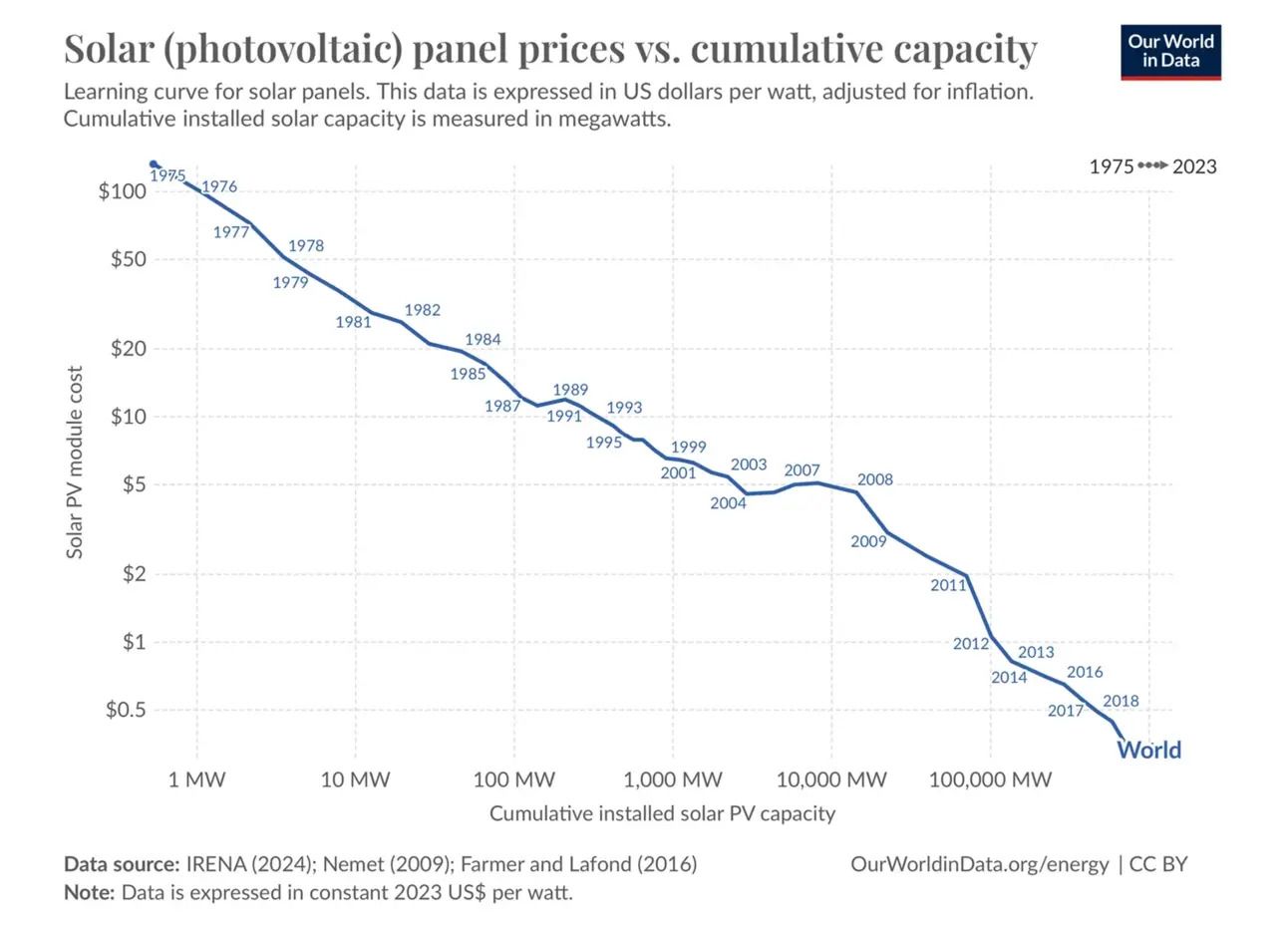- Supercool
- Posts
- 🌐 Clean Energy Is Dead. Long Live Clean Energy.
🌐 Clean Energy Is Dead. Long Live Clean Energy.
America invented the clean energy future. Now, it may be dismantling it, just as technologies reach a global tipping point.
Politics Recede, Technology Surges.
Last week, the clean energy transition hit a speed bump. The Big Beautiful Bill (BBB) rolled back U.S. clean energy funding and incentives that have powered American innovation and investment, just as global investment tops $2 trillion a year, nearly twice the level of fossil fuels.
Still, in our conversations with CEOs featured on Supercool, we’re not hearing panic. We’re hearing frustration. The BBB isn’t killing the most innovative climate companies. It’s just creating turbulence—wasting time, siphoning resources, and distracting from the inevitable future.
On Thursday, the day the bill passed in Congress, I spoke with David Roberts, perhaps the most prominent clean energy journalist of our time. He is the newsletter writer and podcast host behind Volts.
The week before, I listened to David’s interview with Congressman Mike Levin. The focus was the Big Beautiful Bill and its implications for the rollback of American dynamism, just as China surges ahead.
Congressman Levin pointed to a reason his Republican colleagues were a blend of willing and eager to gut clean energy that caught me by surprise.
It’s not climate denial. It’s economic denial.
Republicans, he contended, refuse to believe their own eyes. Not just as it pertains to the billions of dollars in manufacturing investment that the IRA had started flowing into their districts for solar, wind, EVs, and battery storage…
…But also on the larger global economic trend lines showing fossil fuels and gas-powered cars already in terminal decline.
While EVs surge globally, the dramatic price declines in batteries now enable more regions worldwide to operate on round-the-clock solar energy.
Weird Magic
Here’s where David picked up the story. Solar energy, he said, is different from fossil fuels.
Solar panel costs have declined by 99% since 1975.
To grasp how cheap solar has become, consider this: in the Netherlands and Germany, it’s now cost-effective to build fences around gardens and sheep farms using solar panels, because they’re cheaper than wood.
And yet for decades, no one—not even the most optimistic forecasters—predicted solar's astonishing price decline.
Not the International Energy Agency, with its rigorous modeling. Not even Greenpeace.
"The only organization that even came close was Greenpeace," David told me, "and even they underestimated how fast it would happen."
Everyone assumed the magic would wear off. But it didn’t. The cost kept falling—steadily, predictably, almost eerily—like a law of physics no one fully understands.
David calls it weird magic.
A learning curve so consistent it feels like cheating.
And if that curve holds for another decade—and there’s no compelling reason it won’t—we’re headed for a world of trivially cheap energy. Solar so cheap it could power our species into a fundamentally different chapter of life.
Not just cheaper energy.
Abundant, almost unbounded energy.
The kind that makes sci-fi futures plausible.
We talk about AGI as world-changing. David argues that energy abundance could be even more profound.
"We’ve never had access to unbounded, abundant energy," he said. "We’re not even aware of a life form in the universe that has. We literally don’t know what that looks like."
That’s the moment we’re in.
And yet—politically, culturally—we’re sleepwalking through it.
U.S. politicians are walking away from the very policies that made America a clean energy leader. We invented solar, batteries, EVs, and smart grid tech. Now we’re ceding the field to China.
“This bill is a white flag,” David told me. “China is focused on EVs, batteries, and solar. They’re shaping their economy around them. Meanwhile, we’re stepping to the sidelines.”
The Grid Awakens
This isn’t about ideology.
It’s about economics.
Fossil fuels are finite, extractive, and ultimately expensive. Solar is a technology. And technologies improve. That’s the fundamental split David wants more people to understand.
That shift—cheaper solar, better tech—sets the stage for what comes next: A full rethinking of the grid.
Most Americans rarely give it a thought.
We talk about airports. Highways. Bridges. When a politician says we need to fix aging subways, everyone nods. But the grid—the wires and substations that make electricity appear at the flip of a switch? We take it for granted. Until it goes out.
A storm hits. Power’s down. Everyone’s temporarily annoyed. Life moves on.
But out of view, something fundamental is shifting.
More and more of modern life runs on electricity: vehicles, appliances, heating, even cooking. And as more of the economy plugs in, every electron starts flowing through a single system:
The grid.
"If I were president," David said, "I’d tell the country: the future is the grid."
Today, just 20% of energy use is electric. But solving climate change means switching nearly everything to electricity—then cleaning up how that electricity is produced.
If energy is life, the grid is about to become its most essential life force.
But that doesn’t necessarily mean more poles and wires.
The traditional grid was built around big, centralized power plants:
Coal and gas-fired stations
Nuclear reactors
Hydroelectric dams
Utility-scale wind and solar farms
Some of these are scaling fast. Others are phasing out. But all rely on centralized generation and long-distance transmission.
What’s emerging now is more local, more nimble, and trending more distributed:
Rooftop solar
On-site storage
Smart buildings
Microgrids
Virtual power plants (VPPs)
Households and businesses aren’t just consuming energy. They’re producing it, storing it, and sending it back.
The biggest wildcard in this system? It’s not power generation.
It’s demand.
Demand Is the New Supply
For over a century, the job of the grid was to keep up with when and where people needed power—no matter the spike, no matter the surge. Supply had to follow demand.
Even without solar and wind, demand has always been the hard part to manage. It spikes at dinner time. Drops at midnight. Swings with the seasons.
Now, with smart tech, demand can be shaped. Buildings can shift when they use energy—automatically, invisibly, without any disruption to occupants. That’s demand response.
David put it simply: "Demand is becoming as controllable as supply. Maybe even more."
This isn’t just about hardware. It’s about intelligence. Software is making the grid dynamic—hyper-responsive, capable of adjusting autonomously in real-time.
And that changes what’s possible.
Demand flexibility is what makes full electrification work. As homes, vehicles, factories, and cities plug into the grid, we can’t just build our way out of the strain. We need to shift energy use—automatically, intelligently, and invisibly—so clean electricity goes further, costs less, and stays reliable.
That’s what demand response unlocks: optimization so we can reach decarbonization.
That’s the grid David wants people to see—not static and centralized, but dynamic, distributed, and alive.
Supercool Takeaway
Politics is retreating. Technology isn’t.
Solar keeps getting cheaper. Batteries keep scaling. Buildings are getting smarter. Demand is becoming dynamic. The grid is evolving into something more flexible, more intelligent, more alive.
Where it’s headed isn’t just decarbonization. It’s the foundation for a future that could be the stuff of sci-fi fantasy.
A future awash in clean, abundant, nearly free energy—delivering the full promise of AI, desalination, global food security, even space travel.
As David said, "We’ve never had access to unbounded, abundant energy. We literally don’t know what that looks like."
The data tells us we’re about to find out.
And in this pivotal moment—bright or bleak, optimistic or pessimistic—David reflects on the famous quote from Camus: "The only sane approach is to imagine Sisyphus happy."
His message: just do the work.
The low-carbon future is upon us. Now we must continue bringing it to life.
Listen to this podcast episode on Apple, Spotify, YouTube, and all other platforms.
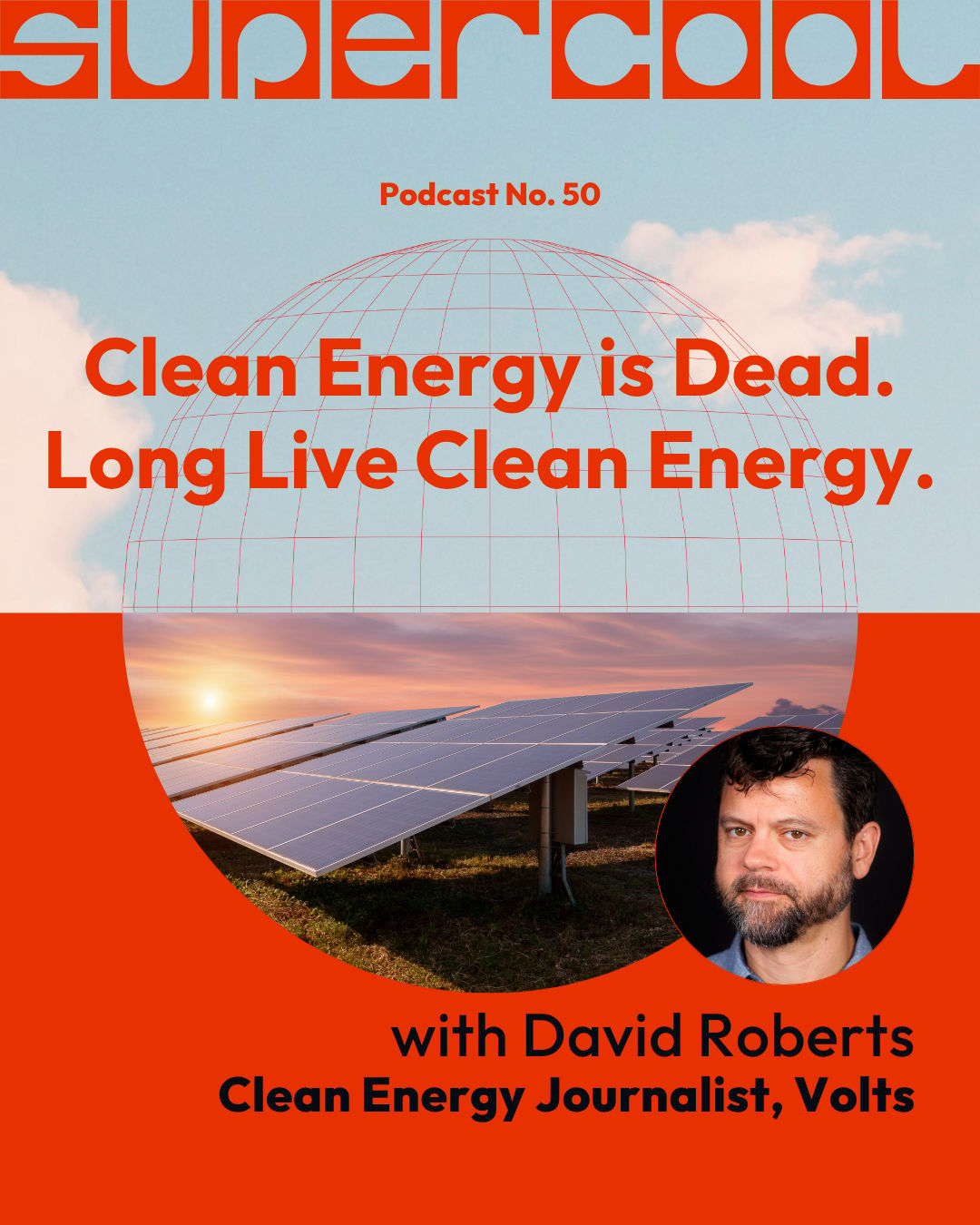
↓
This Week’s Supercool Sponsor

Built to last. Designed to inspire.
Mill is sleek, sculptural, and capable of exerting 288 lbs of force. Each food recycler is crafted by hand in North America and engineered by leaders from Apple and Nest.
Mill transforms your uneaten food into nutrient-rich food grounds and compost, for use at home and in your community.
Buy, finance, or rent your Mill Food Recycler.
↓
Stat of the Week: 22%
That’s how much the levelized cost of a solar-plus-battery power plant dropped in just one year. Why? The average global price of a battery pack fell 40% from 2023 to 2024, according to David Roberts (Volts).
Quote of the Week:
The only outfit that projected solar costs anywhere close to reality was Greenpeace. And they weren't even really doing modeling. They were just putting their hopes down on paper. And even they undershot it.
↓
⚡ Where the Grid Is Going
As David Roberts points out, where the grid goes, so goes the clean energy future. Here’s how companies we’ve previously featured on Supercool are building it:
Siemens Energy
Tim Holt, Board Member and Head of Grid Technologies, told us it took 150 years to build the grid we have—and now we need to double it in 15 years, then double it again. Siemens is delivering high-voltage infrastructure and autonomous control systems to match that scale.
Wärtsilä
Dave Hebert, Global VP of Sales & Strategy, told us Wärtsilä doesn’t chase easy projects—they build the hardest battery systems on Earth, from hurricane zones to remote Caribbean islands and the Arizona desert. Their GEMS platform acts like a “supercomputer at the edge,” optimizing power flow and turning storage into reliable grid infrastructure.
Enphase
Raghu Belur, co-founder and SVP, told us Enphase builds one piece of standardized hardware for its microinverters and then lets the software do the adapting. “Software is the layer that gives us speed and scale,” he said. “It lets us meet local requirements through code, not factories.” From California to Germany to India, the result is faster deployments, easier compliance, and a consistent experience across markets.
Sunrun
Mary Powell, CEO of Sunrun, told us what made the shift possible from its home solar beginnings to a storage-first company powering virtual power plants across the U.S.
By combining customer trust, utility partnerships, and simple, elegant storage design, Sunrun turns neighborhoods into grid assets.
Renew Home
Jeff Gleeson, Chief Product Officer at Renew Home, told us the future isn’t just about how homes consume power—it’s about how they respond. By embedding automation into thermostats and appliances, Renew Home makes household demand flexible and grid-friendly by default. It’s not demand response as a service. It’s grid participation built into everyday life.
↓
Where Supercool traveled this week:
Podcasts:
Less Talk, More Action: The Supercool Way: Solving Climate Challenges with Profit and Purpose
Today in Space: Climate Innovation and Entrepreneurship with Josh Dorfman
↓
Interested in Advertising with Supercool?
Connect with future-forward decision-makers seeking next-gen climate innovations. Reach out to discuss how Supercool’s platform can help. Just hit reply to this email.
↓
Not yet subscribed to Supercool?
Click the button below for weekly updates on real-world climate solutions that cut carbon, boost the bottom line, and improve modern life.
🌐
